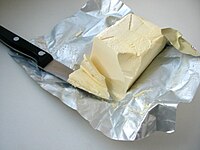
Photo from wikipedia
Dietary fat intake in the Chinese population has increased. The PURE (prospective urban rural epidemiology) study concluded the potential advantage of total fat and saturated fats (SFA) over carbohydrates on… Click to show full abstract
Dietary fat intake in the Chinese population has increased. The PURE (prospective urban rural epidemiology) study concluded the potential advantage of total fat and saturated fats (SFA) over carbohydrates on blood lipids with the inaccurate assessment of dietary fats. We investigated the dietary fat profile among 48,315 participants (aged 30–70 years, national representative) from the China Nutrition and Health Surveillance (2015–2017), determined the relationship of various fats with blood lipid biomarkers in the selected 39,115 participants, and compared the results with the PURE study. Dietary fat intake was calculated by using 3 days of 24 h recalls and food inventory. Serum lipid biomarkers were assessed at morning fasting state by health professionals. Plant fats (21.5% of total energy (TE)) dominated in total fat intake (69.5 g/day, 35.6% TE), with monounsaturated fats (MUFA) in the largest (13.8% TE) portion and plant oils as the major source (43.7%). Two thirds of the population consumed more than 30% TE from dietary fats and nearly half more than 35%, while 26.4% of them exceeded 10% TE from SFA. Total fat was positively associated with total cholesterol (TC), low-density lipoprotein cholesterol (LDL-c), but also high-density lipoprotein cholesterol (HDL-c), and negatively with triglyceride (TG)-to-HDL-c ratio (TGHDL) (all p-trend < 0.05). Replacing total fat with carbohydrate yielded adverse changes in most biomarkers (higher LDL-c, TG, and TGHDL, lower HDL-c, all p < 0.05) when total fat was low (<34.9% TE). Regardless of fat intake level, replacing plant fat or polyunsaturated fats (PUFA) with carbohydrate yielded the most adverse changes (higher TC, LDL-c, TG, TC-to-HDL-c ratio (TCHDL), and TGHDL, but lower HDL-c, all p < 0.01), while replacing animal fat/SFA with plant fat/PUFA yielded the most favorable changes (lower all biomarkers, all p < 0.01). The results suggested a less harmful effect of carbohydrate on blood lipids when total fat was high, and more beneficial effect of unsaturated fats, than the PURE. In conclusion, dietary fat intake in Chinese adults had reached quite a high level, but with a different profile from Western populations. Replacement of SFA (animal fat) with PUFA (plant fat) could most effectively improve blood lipids, while replacement with carbohydrate could slightly benefit only when total fat was high. The present results may be more applicable to the Chinese population than the PURE study.
Journal Title: Nutrients
Year Published: 2022
Link to full text (if available)
Share on Social Media: Sign Up to like & get
recommendations!